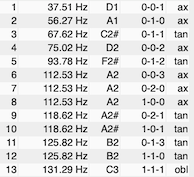Chapter One: An Acoustics Primer

13. What are standing waves? | Page 2
Room Modes:
Listening and recording environments are extremely susceptible to undesirable standing wave effects whereby certain resonant frequencies are unduly enhanced at certain spots and completely eliminated at others, as mentioned on the resonance page. Hard parallel walls, perpendicular floors and ceilings, without obstructions, absorption, diffraction or other treatment make for a playground of standing wave problems, particularly in rooms where one or two dimensions are interval multiples of another (with the worst example perhaps being a cube). Because of the three-dimensional interference, the interactions of reflecting sound waves becomes extremely complex. Room mode calculators will often list three sets of resonances—axial measures resonance between two opposing surfaces (wall to opposite wall, ceiling to floor), tangential measures resonance between four surfaces (four walls or two opposing walls and ceiling plus floor), and oblique measures resonant reflections that hit all six surfaces. Axial modes, which in a real environment have the least attenuated reflections are often the most significant and most addressed by planning room size or treatment. However, the other two mode types combined may also pose issues, though individual tangential modes are -3dB lower, and individual oblique modes are -6dB lower than the more direct axial modes.
Many online room mode calculators are available. We had linked to this one from Trikustik GesmbH earlier. You will see results like this:

To understand what is going on in the calculation and listing, here is the basic formula used to determine these modes.

LEGEND: Fmode is the frequency of a particular room mode, L=room length, W=room width, H=room height. Keep speed of sound and dimensions in same units (meters, feet, etc.)
p, q and r represent the mode orders of the resonant frequency for a particular dimension and are usually presented as an ordered list, so using this formula 1-0-0 would measure the first axial mode of the room length, and 2-0-0 would measure the second axial mode for the room length. 0-1-0 would measure the first axial mode of the room width. For a tangential mode, use two integers and one zero, so 0-1-1 would give the tangential mode of the the room width and height, and for oblique, use all non-zero integers (such as 1-2-6).
In addition, interactive 3D models are available, such as this falstad.com one below. If you read the directions of the linked simulation, you can put your new-found knowledge of p's and q's to good use. This simulation shows the interaction of three axial modes, all the 7th mode only (so 7-0-0, 0-7-0, and 0-0-7). The green indicates maximum pressure and the red indicates minimum pressure, with black being the pressure nodes.
Room Standing Wave Simulation
Simulation created with free Falstad applets at www.falstad.com. Try them!Mitigating Standing Waves in Rooms
It is extremely difficult to completely eliminate all standing waves in a room, but fortunately the main concerns are normally with axial frequencies below approximately 350 Hz. A more exact number is given by the Schroeder frequency you will find in some of the online room calculators like the one linked above. Many studios employ bass traps in the corners and back wall to absorb specific resonant low frequencies that accumulate at the pressure antinodes. These are similar to tunable Helmholtz resonators, which also absorb these problematic frequencies. Placement of both of these at the appropriate antinode spot(s) is important. Where you locate your mixing desk or listening spots is very important (completely in the corner or exactly halfway back can be discarded right away). Designing rooms with non-parallel and less reflective walls and with dimensions that are non-integer multiples of each other helps, as do diffusion and refraction panels on the walls and ceiling to a lesser degree, since these do not absorb or reflect much below the Schroeder frequency. Interior barriers such as furniture is of limited help. EQ'ing down problematic frequencies is tempting, but remember your final product will be played back in other environments. Moving around your room is likely to change your opinion of what needs to be adjusted. Of course, if your budget is up to it, you can hire a profession acoustician with studio experience to design your environment (see well-known designer Russ Berger's site for some awesome studio design eye candy).
Auralex, a company that sells acoustic treatment products, has a great online educational series on studio design and treatment called Acoustics 101, which is worth reading before you setup a studio.